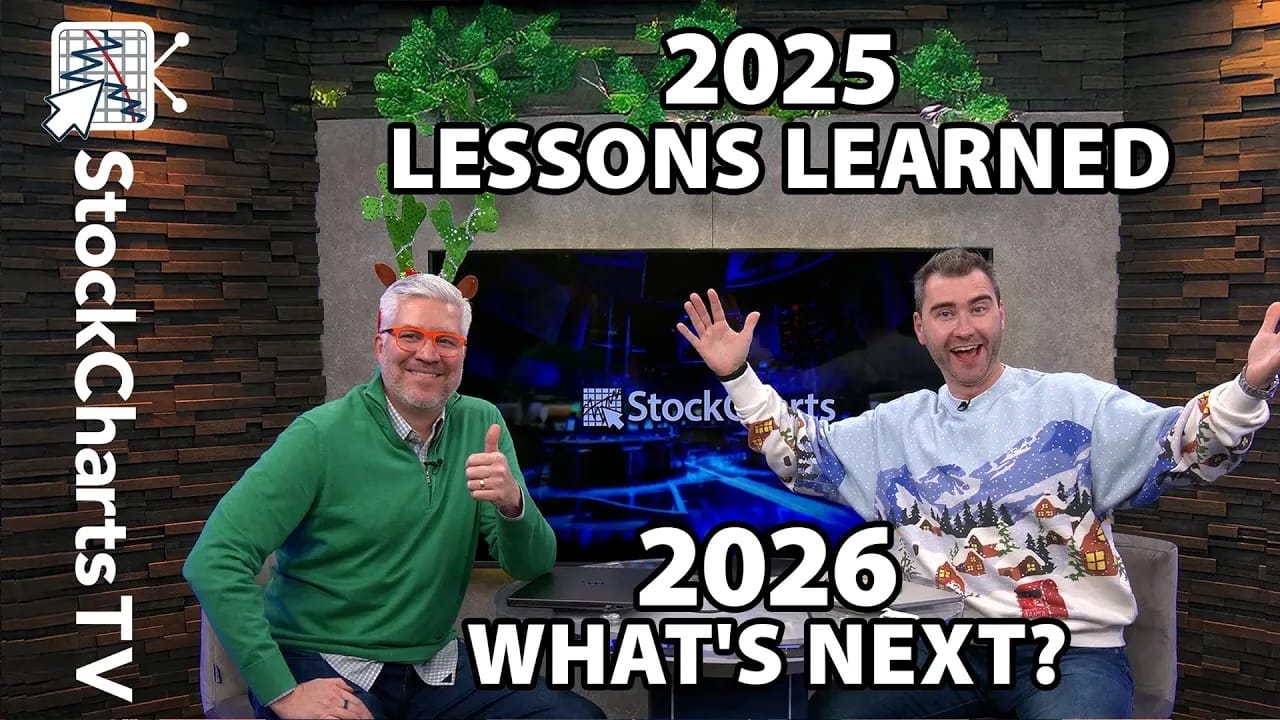FINANCE SECTOR LEADS MARKET LOWER -- EURO PLUNGES ON S&P DOWNGRADE -- GERMAN DAX AND FRENCH CAC FALL -- BOUNCE IN TREASURIES COULD BE NEGATIVE FOR STOCKS -- RELATIVE PERFORMANCE PERKS UP FOR SMALL-CAPS AND THE NASDAQ
FINANCE SECTOR LEADS MARKET LOWER... Link for todays video. An earnings miss from JP Morgan weighed on the finance sector and the market early Friday. Chart 1 shows the S&P 500 ETF (SPY) dipping below 128 and filling Tuesdays gap. Even though SPY closed higher Wednesday and Thursday, there was no real follow through to this gap. A filling of the gap is short-term negative, but not enough to change the medium-term trend, which is still up. Keep in mind that SPY was up some 7.5% from its late December low (three weeks ago). With stocks short-term overbought after a strong three week run, some sort of pullback or consolidation is normal. SPY broke resistance in the 126 area and this zone turns into the first support zone to watch. A move below 124 would erase this years gains and negate the breakout.

(click to view a live version of this chart)
Chart 1
Chart 2 shows the Finance SPDR (XLF) falling over 1% early Friday. As with SPY, the Finance SPDR was short-term overbought after a surge from 12.3 to 14 the last three weeks (13%). The ETF hit resistance from the late October high and the 50% retracement mark. Broken resistance in the 12.8-13.3 area turns into the first support zone to watch. Chart 3 shows JP Morgan (JPM) advancing from support around 28 in late November to resistance around 37 in early January. The stock is up significantly and entitled to some sort of consolidation or correction.

(click to view a live version of this chart)
Chart 2

(click to view a live version of this chart)
Chart 3
EURO PLUNGES ON PROSPECTS OF S&P DOWNGRADE ... Rumors are circulating that Standard & Poors will downgrade the sovereign debt of some Euro-zone countries. In particular, Bloomberg reports that France and Austria will loose their AAA ratings. The market expected some sort of downgrade at some point this year, but perhaps not quite this soon. Even though downgrades are still just rumors at this point, the Euro gave back Thursdays gains with a sharp decline early Friday. Chart 4 shows the Euro Currency Trust (FXE) falling over 1% and moving to a new low for January. The overall trend is down and the ETF is quite oversold after an 11+ percent decline since late October. Nevertheless, there are simply no signs of strength or support. Should an oversold bounce materialize, broken support in the 131 area would turn into the first resistance level. The Dollar, of course, is the main beneficiary of a weak Euro. Chart 5 shows the US Dollar Fund (UUP) surging to a new 52-week high early Friday.

(click to view a live version of this chart)
Chart 4

(click to view a live version of this chart)
Chart 5
GERMAN DAX AND FRENCH CAC FALL... Chart 6 shows the German DAX Index ($DAX) falling over 1% with a move back below 6200. Despite this decline, the overall trend since late September remains up. The index most recently broke resistance around 6000 and this level turns into the first support level to watch. A move back below 6000 would argue for a failed breakout. A move below the early December low (5600) would be outright bearish. Chart 7 shows the French CAC Index ($CAC) failing in the 3200-3300 area for at least the sixth time since mid August. There is a ton of resistance in this area. Last weeks low marks first support at 3100 and key support is set at 2900.

(click to view a live version of this chart)
Chart 6

(click to view a live version of this chart)
Chart 7
A BREAKOUT IN TREASURIES COULD BE NEGATIVE FOR STOCKS... Stocks and treasures have been negatively correlated for sometime, which means they move in opposite directions. The indicator window in chart 8 shows the 20-period Correlation Coefficient for the S&P 500 and the 20+ Year T-Bond ETF (TLT). Except for one brief move into positive territory, this indicator has been decidedly negative the last twelve months. While correlation does not mean causation, chartists should watch the recent rise in treasuries because it may adversely affect the stock market. Treasures attract buying interest in a flight to safety, as an alternative to riskier assets (Euro or stocks) or in reaction to negative news on the economy. The main chart window shows the 20+ Year T-Bond ETF (TLT) moving above 120 with a strong move early Friday. The overall trend here is up and the ETF is poised to challenge resistance from the September-December highs. Notice that the pattern over the last 3-4 months looks like an ascending triangle, which is a bullish continuation pattern. Needless to day, a break above resistance would affirm the uptrend. Should TLT fail to break resistance, watch support from the late December and early January lows. A break below this level would be the first significant sign of weakness in treasuries and this would be positive for stocks. Chart 9 shows the 7-10 year T-Bond ETF (IEF) with first support at 103. Chart 10 shows the 10-year Treasury Yield ($TNX) for reference.

(click to view a live version of this chart)
Chart 8

(click to view a live version of this chart)
Chart 9

(click to view a live version of this chart)
Chart 10
RELATIVE PERFORMANCE PERKS UP FOR SMALL-CAPS AND THE NASDAQ ... The Russell 2000 ($RUT) has been underperforming the S&P 100 ($OEX) since late November, but small-cap performance perked up this week. Small-cap performance is important because these stocks are more dependent on the domestic economy, which means they reflect US economic conditions. Small-caps benefit more during an economic expansion and suffer more during an economic dip. Relative strength in small-caps is, therefore, bullish for the stock market as a whole. Chartists can measure small-cap performance using the Price Relative, which is a ratio chart showing the performance of one security relative to the other. Chart 11 shows the $RUT:$OEX ratio rising when small-caps outperform large-caps and falling when small-caps underperform large-caps. Notice how the ratio plunged from early July to early October as small-caps led the market lower. The ratio surged in October, but then moved into a consolidation pattern since early November. A triangle pattern took shape as the range narrowed into December. More recently, notice that the Price Relative shot higher this week and broke above the upper trendline of the triangle. Small-caps are making an outperformance bid and a breakout would be positive for the market. Failure to breakout and a move below the January low would be negative.

(click to view a live version of this chart)
Chart 11
Chart 12 shows Nasdaq performance relative to the NY Composite ($NYA). In general, Nasdaq stocks have higher betas, higher volatility and higher risk than NYSE stocks. This means they represent the appetite for risk. Risk appetite is strong when the Nasdaq outperforms and weak when the Nasdaq underperforms. The Price Relative ($COMPQ:$NYA ratio) surged from mid June to late September as the Nasdaq outperformed the NY Composite. Notice that the NY Composite moved to a new low in early October, but the Nasdaq held its August low. This is why the Nasdaq showed relative strength. The tables turned in October as the Price Relative peaked and moved lower the last three months. The Price Relative surged in 2012 and is now challenging resistance from the December high**. A breakout would show relative strength returning to the Nasdaq and this would be positive for the market.












